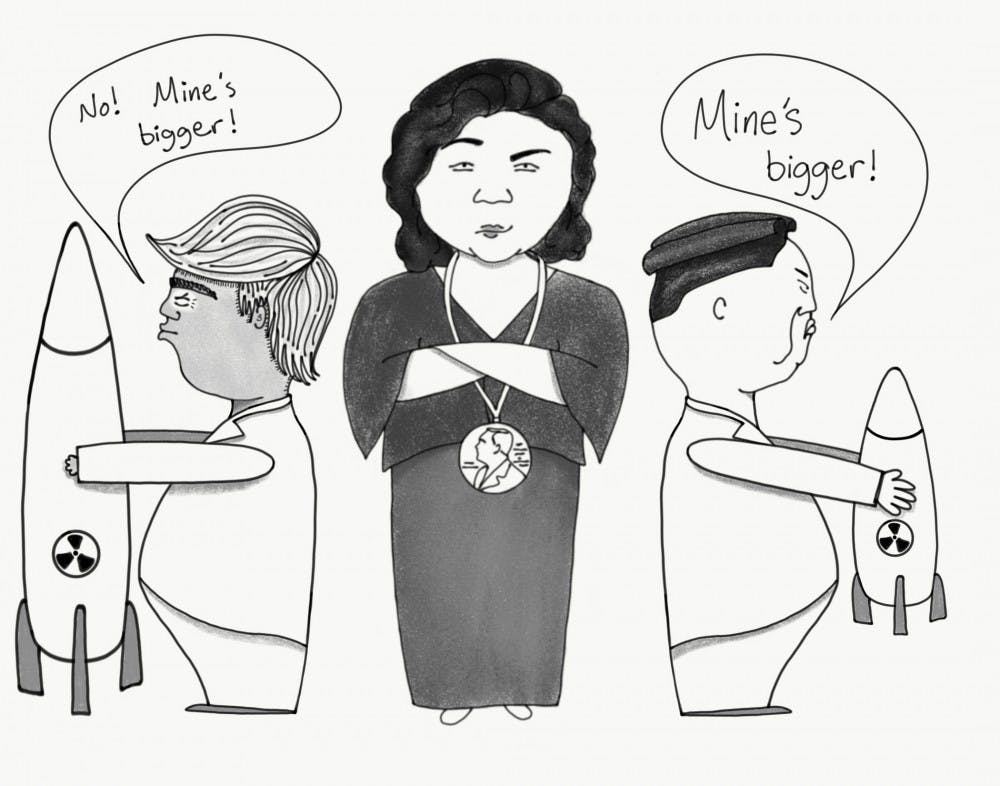Setsuko Thurlow was one mile away from the epicenter of the atomic bomb explosion over the Shima Surgical Clinic in Hiroshima on the morning of Aug. 6, 1945. She reported seeing a blue-white flash, then total darkness.
When she crawled out from the wreckage of the building she was working in, she described seeing dark shapes lumbering towards her, men and women “covered with blood and burned and bludgeoned and swollen, and the flesh was hanging from the bones. Parts of their bodies were missing, and some were carrying their own eyeballs in their hands.”
In a city of more than 340,000 people, nearly one-third of the population was killed. Thurlow watched as Hiroshima burned to the ground.
She was 13 years old.
Seventy-two years later, Thurlow walked across a stage in Oslo to accept the 2017 Nobel Peace Prize for her anti-nuclear activism, given jointly to her and the International Campaign to Abolish Nuclear Weapons.
Not even a month after, President Trump tweeted this:
"North Korean Leader Kim Jong Un just stated that the “Nuclear Button is on his desk at all times.” Will someone from his depleted and food starved regime please inform him that I too have a Nuclear Button, but it is a much bigger & more powerful one than his, and my Button works!"
To the Editorial Board, such frivolous flaunting of these horrific weapons must be met with outrage. It is simply unacceptable that the president of the United States must be reminded that his symbolic bright red launch button is not some toy or plaything, but a harbinger of destruction — that a single atomic bomb can extinguish millions of lives in a blue-white glow.
But even if these hypothetical buttons remain unpressed, the world is not safe from nuclear catastrophe, reminds Beyza Unal, a Chatham House cybersecurity expert.
Because modern-day launch systems are highly dependent on complex electronic safeguards and tracking arrays, they are increasingly vulnerable to cyberattacks designed to remotely launch a nuclear warhead, alter flight paths or falsely signal that a warhead has been launched by a rival state.
Due to the incredibly destructive nature of these weapons, a cyberattack, manufacturing error or simple hardware malfunction could have dire repercussions for humanity on a global scale.
With a long history of near-misses involving these malfunctions, such as when launch control officers lost communications with fifty nuclear missiles in 2010 or when a harmless scientific rocket triggered Russian nuclear alert systems in 1995, the question becomes not if such a failure will occur, but when.
Amid current political tensions fueled by these trigger-happy leaders, complete nuclear disarmament is unfortunately not going to be achieved in the coming years. But when international relationships do improve, the global community must focus on reducing its nuclear stockpile, which is currently at nearly 15,000 warheads—enough to decimate the world and still have thousands of weapons leftover.
Even if a mere 100 of these warheads were detonated, current research suggests the radioactive fallout from such an event would be sufficient enough to cause a planetary nuclear winter, putting billions more at risk of starvation.
Atrocity must not be met with counter-atrocity, and the mere existence of these nuclear stockpiles invites catastrophe to our doorstep.
When Trump was elected, the symbolic doomsday clock was moved to two and a half minutes from midnight.
Whether through internal non-proliferation efforts or international agreements, we must do everything in our power to prevent those final minutes from slipping away.




